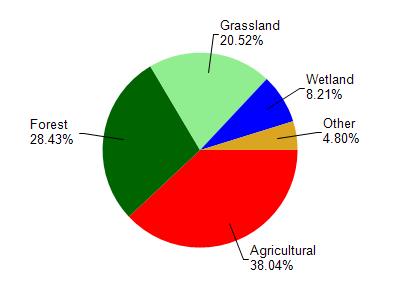Washburn
No
No
No
Fish and Aquatic Life
Overview
Grassy Lake, in the Yellow River Watershed, is a 38.60 acre lake that falls in Washburn County. This lake is managed for fishing and swimming and is currently not considered impaired.
Date 2011
Author Aquatic Biologist
Historical Description
A soft water, seepage lake, it is landlocked and subject to winterkill conditions. The present fishery is probably bluegills and bullheads. At least 60 percent of the lakeshore is marsh wetland. The remainder is upland with mixed hardwoods and an open grassy area on the north side. The lake level fluctuates to some extent which increases the winter freeze-out potential.
The lake basin is elongated east and west, and the latter basin is deeper. Most of the east end has an abundance of floating and submergent vegetation. The littoral bottom type is 70 percent muck and 30 percent sand. Nesting waterfowl include the local puddle ducks and loon. Furbearer use, except perhaps for muskrat, is not significant. There is no private development on the lakeshore since the entire lake is Washburn County Forest land. Public access is limited to walk-in trail.
Source: 1978, Surface Water Resources of Washburn County Grassy Lake, T37N, R13W, Section 27, 28, Surface Acres-37.5, Maximum Depth-10 feet, M.P.A.-40 ppm, Secchi Disk-5 feet.
Date 1978
Author Surface Water Inventory Of Wisconsin
Condition
Wisconsin has over 84,000 miles of streams, 15,000 lakes and milllions of acres of wetlands. Assessing the condition of this vast amount of water is challenging. The state's water monitoring program uses a media-based, cross-program approach to analyze water condition. An updated monitoring strategy (2015-2020) is now available. Compliance with Clean Water Act fishable, swimmable standards are located in the Executive Summary of Water Condition in 2018. See also the 'monitoring and projects' tab.
Management Goals
Wisconsin's Water Quality Standards provide qualitative and quantitative goals for waters that are protective of Fishable, Swimmable conditions [Learn more]. Waters that do not meet water quality standards are considered impaired and restoration actions are planned and carried out until the water is once again fishable and swimmable
Management goals can include creation or implementation of a Total Maximum Daily Load analysis, a Nine Key Element Plan, or other restoration work, education and outreach and more. If specific recommendations exist for this water, they will be displayed below online.
Monitoring
Monitoring the condition of a river, stream, or lake includes gathering physical, chemical, biological, and habitat data. Comprehensive studies often gather all these parameters in great detail, while lighter assessment events will involve sampling physical, chemical and biological data such as macroinvertebrates. Aquatic macroinvertebrates and fish communities integrate watershed or catchment condition, providing great insight into overall ecosystem health. Chemical and habitat parameters tell researchers more about human induced problems including contaminated runoff, point source dischargers, or habitat issues that foster or limit the potential of aquatic communities to thrive in a given area. Wisconsin's Water Monitoring Strategy was recenty updated.
Grants and Management Projects
| Project Name (Click for Details) | Year Started |
|---|
|
|
Monitoring Projects
| WBIC | Official Waterbody Name | Station ID | Station Name | Earliest Fieldwork Date | Latest Fieldwork Date | View Station | View Data |
|---|
| 1851500 | Grassy Lake | 10006736 | Grassy Lake | 9/5/2000 | 10/3/2016 | Map | Data |
|

Watershed Characteristics
Grassy Lake is located in the Yellow River watershed which is 239.35 mi². Land use in the watershed is primarily agricultural (38%), forest (28.40%) and a mix of grassland (20.50%) and other uses (13.00%). This watershed has 415.31 stream miles, 2,929.80 lake acres and 11,565.29 wetland acres.
Nonpoint Source Characteristics
This watershed is ranked High for runoff impacts on streams, Not Available for runoff impacts on lakes and High for runoff impacts on groundwater and therefore has an overall rank of High. This value can be used in ranking the watershed or individual waterbodies for grant funding under state and county programs.However, all waters are affected by diffuse pollutant sources regardless of initial water quality. Applications for specific runoff projects under state or county grant programs may be pursued. For more information, go to surface water program grants.